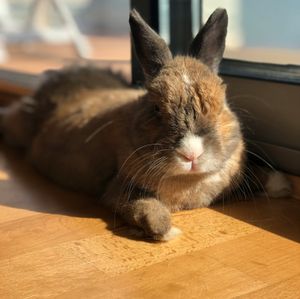
Rabbits have a delicate, fragile skeleton and very powerful hind leg muscles. This combination can lead to serious problems when rabbits either struggle during handling or kick out too violently resulting in acute pelvic limb paralysis is vertebral fracture or luxation (fractures more common). This happens because the muscular hindquarters of rabbits act as a fulcrum against the spine. This most commonly occurs in the lower back, or lumbosacral region of the spine. How affected a rabbit is by this injury reflects the area of the spine affected and the degree of damage.
Rabbits with this condition acutely present with non-ambulatory paralysis or weakness of the hind legs.
Other possible causes of these symptoms include trauma, spinal deformities (lordosis, kyphosis, scoliosis), spondylitis (infection of the vertebrae), spondylosis (degenerative disease of the spinal column), and spinal tumors.
If your veterinarian suspects this condition in your rabbit they may recommend radiographs, a CT scan, or an MRI. Additional testing that might also be warranted includes a blood biochemistry panel and a complete blood count.
Treatment of this condition hinges on providing adequate pain control and strict cage rest. Commonly prescribed pain medications include buprenorphine, gabapentin, and meloxicam. Patients should be strictly rested for 4-6 weeks with reduced cage space. Climbing, play, and exercise need to be avoided. In many patients, they will be left unable to urinate on their own and their bladder will require assistance in emptying through expression throughout the day, about every 6 hours. Cleanliness is paramount to prevent the development of urine scalding and skin ulcers. Surgical options are limited and require referral to a neurologist. The use of a wheelchair can be employed for patients where function does not return.
The prognosis is guarded to poor for a return to function. Patients with just hind leg weakness have a better prognosis than those with full paralysis and loss of bladder function. In patients where quality of life is a concern or pain can not be adequately controlled, humane euthanasia is always a consideration.
Copyright © All Rights Reserved
